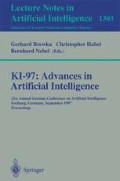Abstract
Inspired by the work of Elman and Wiles [15] and based on the notions developed within the theory of dynamical systems it is shown how a simple recurrent connectionist network with a single hidden unit implements a counter. This result is exemplified by showing that such a network can be used to recognize the context-free language a n b n consisting of strings of some number n of a's followed by the same number n of b's for n ≤ 250 , whereby the maximum value for n is only restricted by the computing accuracy of the used hardware
Preview
Unable to display preview. Download preview PDF.
References
Arbib, M.A. (1987). Brains, Machines, and Mathematics. 2nd edition: Springer-Verlag.
Feldman, J.A. & Ballard, D.H. (1982). Connectionist Models and Their Properties. Cognitive Sciene, 6(3), 205–254.
Fodor, J.A. & Pylyshyn, Z.W. (1988). Connectionism and Cognitive Architecture: A Critical Analysis. In Pinker & Mehler (Eds.), Connections and Symbols (pp. 3–71): Springer-Verlag
Hölldobler, S. (1993). Automated Inferencing and Connectionist Models. Technical Report AIDA-93-06, Intellektik, Informatik, TH Darmstadt, (Postdoctoral Thesis).
Kalinke, Y. & Störr, H.-P. (1996). Rekurrente Neuronale Netze zur Approximation der Semantik akzeptabler logischer Programme. In Bornscheuer, S. & Thielscher, M. (Eds.), Fortschritte in der Künstlichen Intelligenz (p. 27), KI-96 Workshop: Dresden University Press.
McCulloch, W.S. & Pitts,W. (1943). A logical Calculus and the ideas immanent in nervous activity. Bulletin of Mathematical Biophysics, 5,115–133.
Newell, A. (1980). Physical Symbol Systems. Cognitive Science, 4,135–183.
Pinkas, G. (1991). Symmetric Neural Networks and Logic Satisfiability. Neural Computation, 3.
Pollack, J.B. (1988). Recursive auto-associative memory: Devising compositional distributed representations. In Proceedings of the Annual Conference of the Cognitive Science Society, pp.33–39.
Rumelhart, D.E. & Hinton, G.E. & McClelland, J.L. (1986). A General Framework for Parallel Distributed Processing. In Parallel Distributed Processing: MIT Press.
Sejnowski, T.J. & Churchland, P.S. (1989). Brain and Cognition. In Posner,M.L(Ed.), Foundations of Cognitive Science: MIT Press.
Shastri, L. & Ajjanagadde, V. (1993). From Associations to Systematic Reasoning: A Connectionist Representation of Rules, Variables and Dynamic Bindings using Temporal Synchrony. Behavioural and Brain Sciences, 16(3). pp. 417–494.
Stolcke, A. (1989). Unification as Constraint Satisfaction in Structured Connectionist Networks. Neural Computation, 1(4), pp.559–567.
Wiggers, W. & Enrich, C. & Roth, G. & Schwegler, H. (1995). Salamander und Simulander. Neuroforum, 1.
Wiles, J. & Elman, J. (1995). Learning to Count without a Counter: A case Study of dynamics and activation landscapes in recurrent networks. In Proceedings of the Seventeenth Annual Conference of the Cognitive Science Society, Cambridge, MA:MIT Press.
Author information
Authors and Affiliations
Editor information
Rights and permissions
Copyright information
© 1997 Springer-Verlag Berlin Heidelberg
About this paper
Cite this paper
Hölldobler, S., Kalinke, Y., Lehmann, H. (1997). Designing a counter: Another case study of dynamics and activation landscapes in recurrent networks. In: Brewka, G., Habel, C., Nebel, B. (eds) KI-97: Advances in Artificial Intelligence. KI 1997. Lecture Notes in Computer Science, vol 1303. Springer, Berlin, Heidelberg. https://doi.org/10.1007/3540634932_25
Download citation
DOI: https://doi.org/10.1007/3540634932_25
Published:
Publisher Name: Springer, Berlin, Heidelberg
Print ISBN: 978-3-540-63493-5
Online ISBN: 978-3-540-69582-0
eBook Packages: Springer Book Archive

